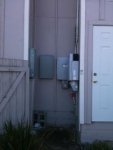ArCal
Member
- Location
- Arcata, CA
I have an existing situation where a 200 amp electrical panel is located in an alcove with 3'4" in front. The owner just installed a PV system and placed the inverter on the wall in front of the panel. Now there is only 30" between the front of the panel and the inverter. He is going to have to remove the inverter to get the 36" required. This bought up a question. If the inverter was installed in front of the panel, what would be the required distance from it to the inverter? Table 110.26(A)(1) notes 3 different conditions which determine the space in front of a panel, would the inverter create condition 2 or 3? I would appreciate any comments.
Thank you.
Thank you.


